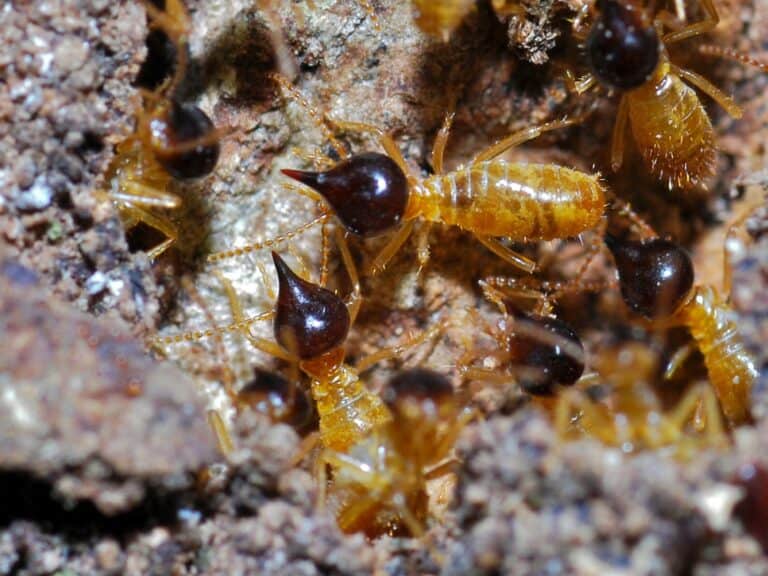Spiny Orb Weaver Information
Appearance:
The Spiny Orb Weaver, also referred to as Spiny Spiders, are very unique in appearance. They are small; approximately ½” in length, or less. They are very brightly colored and are distinguishable by a hard, shell-like abdomen that has six points, or spines, around the perimeter. They are pale yellow or white, and they have black or red markings along the edge of their spines.

Location and Behavior Patterns:
Spiny Orb Weavers get their name from the webs that they spin, which are orb-shaped and flat, as well as the spines they have on their abdomens. Their webs are usually located high off of the ground, perhaps in the bushes, on trees, along the gutters of a home, or underneath outside light sources. They feed on insects, both crawling and flying insects, that venture too close to their webs. This type of spider is non-aggressive towards humans.
Details For Spiny Orbweave Spiders
| Other Common Names: | Crab-like orbweaver, spinybacked orbweaver and spiny orbweaver spider |
| Genus / Species: | Gasteracantha cancriformis |
| Size: | Males 1/16″-1/8″; females 3/8″ |
| Web: | Orb webs up to 10-12” across. Larger webs have ten to 30 radii |
| Type of Beneficial: | Insect predator |
| Prey: | Orb Weave Spiders are preditors to a wide range of flying prey including flies, moths, small beetles, wasps, bees, mosquitoes and more. |
| Distribution: | Widespread across the Galveston-Houston region but are also represented in Florida. |
| Additional Notes: | Spiny orb weavers have a broad, hard abdomen that can be white, orange, or yellow with red markings. |
Treatment:
The Spiny Orb Weaver is a beneficial spider because they eat on other pests, such as flies, mosquitos, beetles, and moths. If at all possible, they should be left alone, so they can help keep the population down of other pests that are bothersome for property owners. If, however, you have a lot of Spiny Orb Weavers around your property, you may wish to investigate why you have so many insects around for them to eat. An abundance of other pests may need targeted treatment by a professional.
Help With Orbweave Spiders
Call Florida Environmental for environmentally friendly pest control. We can help with any spider infestation issues all over south florida.
FAQS:
Are Florida orb weaver spiders poisonous?
Orb weavers are capable of biting. However, they do it infrequently, and their bites do not threaten human health. They pose no danger to humans but can be a nuisance when they construct big webs in locations that are inconvenient for people to access.
Where Is The Spiny Orb Weaver Found?
They are most commonly found in the southern states, from southern California to Florida. In residential areas, the spiny-backed orb weaver is commonly found on trees and shrubs around houses and nurseries. Citrus groves are a favorite habitat for this particular species.
Are Orb Weavers Aggressive?
Although they have a fearsome reputation, orb weavers do not pose a significant health risk to people. They are not aggressive; you are more likely to see them run away than bite you. However, they will bite in self-defense, but the bite is said to merely cause some localized pain, with reports indicating that the sensation is comparable to that caused by a wasp sting.
How Long Do Orb Weaver Spiders Live?
In regions with harsh winters, the female orb weaver will lay a large clutch in the autumn and then cover it with a thick layer of silk. She will perish when the first frost hits, leaving her eggs in the nest for her young to hatch the following spring. On average, the life span of an orb weaver is between one and two years.
How Big Do Orb Weaver Spiders Get?
The length of a female golden orb weaver ranges from two to six inches, whereas a male’s length ranges from half an inch to two inches. Orb weavers will consume everything that becomes entangled in their webs. This can include grasshoppers, mosquitoes, bees, wasps, other stinging insects, tiny moths and butterflies, and flies.
How Do You Keep Spiny Orb Weavers Away?
You should prune your shrubs and remove any dead leaves, branches, and other waste that has accumulated in the garden. Spiny orb spiders frequently use these as hiding places during the heat of the day, and if you reduce the number of little hiding spaces in your garden, you will make it much less appealing to the spiders.










